This article needs additional citations for verification .(January 2013) |
Cavalry draw is a method used to extract a pistol from a holster, which is designed to carry the pistol butt forward.
This article needs additional citations for verification .(January 2013) |
Cavalry draw is a method used to extract a pistol from a holster, which is designed to carry the pistol butt forward.
The name and technique come from the leather holsters used by the cavalry of both the United States Army and the Confederate States Army, during the Civil War. The pistol was in a covered holster carried high on the cavalryman's right side, but was placed butt-forward for crossdrawing by the left hand. The pistol was considered by the Army to be a secondary weapon, with the right hand used for the saber. Placement on the right permitted an alternative method to be used, allowing the right hand to draw the pistol if the sword were lost in battle.
In practice, however, the "alternative method" became the standard, with the sword being left in its sheath until the pistol and its spare loaded cylinders had been expended.
Later, it was found that the reversed holster can be more comfortable, especially when worn while sitting down, than the normal type holster. In addition, cavalry draw can be performed while sitting, as well as retaining the original off-hand cross draw capability. For these reasons, the FBI used the cavalry draw when they were equipped with short .38 Special revolvers.
| External image | |
|---|---|
The cavalry draw is performed in three steps:
With practice, the cavalry draw can be as fast or even faster than drawing from a normal, butt-rearward holster, because of the assistance of the body in placement of the hand on the pistol stocks.
Not all cavalry used this method of draw, or located their holsters on the right hand side of the body. In the "Manual of Arms for the Sharps Rifle, Colt Revolver and Swords (1861)", [1] which was used by the Union Army, the revolver would have been worn on the left side, in front of the sabre-hook. To draw the revolver, the soldiers were instructed to "pass the right hand between the bridle-arm and the body, unbutton the pistol-case, seize the pistol at the butt, draw it".
"Wild Bill" Hickok was known to have used this draw style to great effect.
In modern times, some SASS members use the form of carry.
The characters Zorro (James Vega played by John Carroll) in the 1937 film serial Zorro Rides Again , and Zorro (Diego Vega played by Reed Hadley) in the 1939 film serial Zorro's Fighting Legion , both famously carry their pistol in a cavalier holster. [2] [ circular reference ] with sword and/or whip in the other hand.
The villain Liberty Valance uses the strong side cavalry draw in John Ford's The Man Who Shot Liberty Valance (1962).
The character of Sam Chisolm (played by Denzel Washington) in the 2016 movie The Magnificent Seven plays a bounty hunter and gunfighter who carries his pistol in a cavalier holster. It was alluded that the character fought for the Union in the Civil War.
The character of Rick O'Connell (played by Brendan Fraser) in the 1999 movie, The Mummy , uses this draw technique with guns on both left and right sides.
The primary antagonist character, Charlie Prince (played by Ben Foster) in the 2007 film 3:10 to Yuma carries two Smith & Wesson Model 3 Schofield Revolvers both worn in cavalry draw holsters.
Several characters in video game Red Dead Redemption 2 , and the Red Dead series, use the cavalry draw method, including Micah Bell (played by Peter Blomquist) and gang co-founder Hosea Matthews.
Wild Bill Hickok, as portrayed in the television show Deadwood , also uses the cavalry draw, which is seen 57 minutes into the first episode.
The International Defensive Pistol Association (IDPA), founded in 1996, is an organization based in Bogata, Texas, that has created a shooting sport based on defensive pistol techniques, using equipment including full-charge service ammunition to solve simulated "real world" self-defense scenarios. Shooters competing in defensive pistol events are required to use practical handguns and holsters that are deemed suitable for self-defense use and concealment garment that can conceal the handgun from view of bystanders.

James Butler Hickok, better known as "Wild Bill" Hickok, was a folk hero of the American Old West known for his life on the frontier as a soldier, scout, lawman, cattle rustler, gunslinger, gambler, showman, and actor, and for his involvement in many famous gunfights. He earned a great deal of notoriety in his own time, much of it bolstered by the many outlandish and often fabricated tales he told about himself. Some contemporaneous reports of his exploits are known to be fictitious, but they remain the basis of much of his fame and reputation.
Gunfighters, also called gunslingers, or in the late 19th and early 20th century, gunmen were individuals in the American Old West who gained a reputation of being dangerous with a gun and participated in gunfights and shootouts. Today, the term "gunslinger" is more or less used to denote someone who is quick on the draw with a handgun, but this can also refer to those armed with rifles and shotguns. The gunfighter is also one of the most popular characters in the Western genre and has appeared in associated films, television shows, video games, and literature.
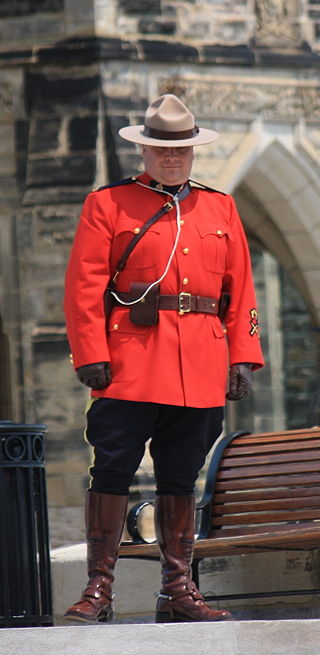
The Red Serge refers to the jacket of the dress uniform of the Royal Canadian Mounted Police. It consists of a scarlet British-style military pattern tunic, complete with a high-neck collar and blue breeches with yellow stripe identifying a cavalry history.
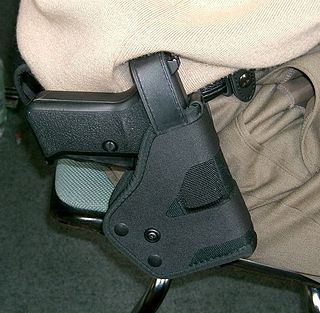
A handgun holster is a device used to hold or restrict the undesired movement of a handgun, most commonly in a location where it can be easily withdrawn for immediate use. Holsters are often attached to a belt or waistband, but they may be attached to other locations of the body. Holsters vary in the degree to which they secure or protect the firearm. Some holsters for law enforcement officers have a strap over the top of the holster to make the handgun less likely to fall out of the holster or harder for another person to grab the gun. Some holsters have a flap over the top to protect the gun from the elements.
Fast draw, also known as quick draw, is the ability to quickly draw a handgun and accurately fire it upon a target in the process. This skill was made popular by romanticized depictions of gunslingers in the Western genre, which in turn were inspired by famous historical gunfights in the American Old West.

The harquebusier was the most common form of cavalry found throughout Western Europe during the early to mid-17th century. Early harquebusiers were characterised by the use of a type of carbine called a "harquebus". In England, harquebusier was the technical name for this type of cavalry, though in everyday usage they were usually simply called 'cavalry' or 'horse'. In Germany they were often termed Ringerpferd, or sometimes Reiter, in Sweden they were called lätta ryttare.

In American English, a pocket pistol is any small, pocket-sized semi-automatic pistol, and is suitable for concealed carry in a pocket or similar space.

A manual of arms was an instruction book for handling and using weapons in formation, whether in the field or on parade. Such manuals were especially important in the matchlock and flintlock eras, when loading and firing was a complex and lengthy process typically carried out in close order. When capitalized, the term has reference to one of several important manuals, such as the British Army manual of 1764, the manual of Frederick the Great or Von Steuben's Regulations for the Order and Discipline of the Troops of the United States, adopted by the Continental Army in 1777. The positions and evolutions contained in such manuals have become the standard for parade drill throughout most of the world.

A service pistol, also known as a personal weapon or an ordnance weapon, is any handgun issued to regular military personnel or law enforcement officers. Typically, service pistols are revolvers or semi-automatic pistols issued to officers, non-commissioned officers, and rear-echelon support personnel for self-defense, though service pistols may also be issued to special forces as a backup for their primary weapons. Pistols are not typically issued to front-line infantry. Before firearms were commonplace, officers and non-commissioned officers typically carried swords.

A handgun is a firearm designed to be usable with only one hand. It is distinguished from a long gun which needs to be held by both hands and braced against the shoulder. Hand guns have a shorter range compared to long guns. The two most common types of handguns are revolvers and semi-automatic pistols, although other types such as derringers and machine pistols also see infrequent usage.

The Colt Model 1848 Percussion Army Revolver is a .44 caliber revolver designed by Samuel Colt for the U.S. Army's Regiment of Mounted Rifles. The revolver was also issued to the Army's "Dragoon" regiments. This revolver was designed as a solution to numerous problems encountered with the Colt Walker. Although it was introduced after the Mexican–American War, it became popular among civilians during the 1850s and 1860s and was also used during the American Civil War.

The Colt Revolving Belt Pistol or Navy Pistol, sometimes erroneously referred to as "Colt Revolving Belt Pistol of Naval Caliber" or "of Navy Caliber", is a cap and ball revolver that was designed by Samuel Colt between 1847 and 1850. Colt first referred to this Revolver as the Ranger Size model, and then Revolving Belt, but the designation "Navy" quickly took over.
The road agent's spin, also known as the "Curly Bill spin" or the "Border roll", was a gunfighting maneuver first identified in the days of the Old West. It was utilized as a ruse when forced to surrender a side arm to an unfriendly party.

The family of Colt Pocket Percussion Revolvers evolved from the earlier commercial revolvers marketed by the Patent Arms Manufacturing Company of Paterson, N.J. The smaller versions of Colt's first revolvers are also called "Baby Patersons" by collectors and were produced first in .28 to .31 caliber, and later in .36 caliber, by means of rebating the frame and adding a "step" to the cylinder to increase diameter. The .31 caliber carried over into Samuel Colt's second venture in the arms trade in the form of the "Baby Dragoon"-a small revolver developed in 1847–48. The "Baby Dragoon" was in parallel development with Colt's other revolvers and, by 1850, it had evolved into the "Colt's Revolving Pocket Pistol" that collectors now name "The Pocket Model of 1849". It is a smaller brother of the more famous "Colt's Revolving Belt Pistol of Naval Caliber" introduced the same year and commonly designated by collectors as the "1851 Navy Model". In 1855 Colt introduced another pocket percussion revolver, the Colt 1855 "Sidehammer", designed alongside engineer Elisha K. Root.
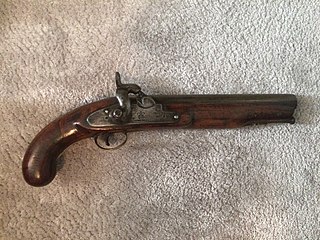
A pistoleer is a mounted soldier trained to use a pistol, or more generally anyone armed with such a weapon. It is derived from pistolier, a French word for an expert marksman.

1937 Pattern Web Equipment was an item of military load-carrying equipment. It replaced the 1908 Pattern and 1925 Pattern—on which it was based—and was standard issue for British and Commonwealth troops from its introduction in 1937, throughout World War II, and in the post-war period until it was superseded by 1958 Pattern Web Equipment. It remained in limited use with Territorial Army and other second-line troops until the mid to late 1970s. Official use of the webbing in Community Cadet Forces and the Combined Cadet Force persisted into the 1980s.

Mughal weapons significantly evolved during the ruling periods of its various rulers. During its conquests throughout the centuries, the military of the Mughal Empire used a variety of weapons including swords, bows and arrows, horses, camels, elephants, some of the world's largest cannons, muskets and flintlock blunderbusses.
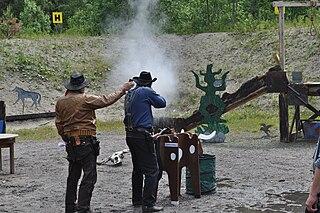
Cowboy action shooting is a competitive shooting sport that originated in the early 1980s, at the Coto de Caza Shooting Range in Orange County, California. Cowboy action shooting is now practiced in many places with several sanctioning organizations including the Single Action Shooting Society (SASS), Western Action Shootists Association (WASA), and National Congress of Old West Shooters (NCOWS), and Single Action Shooting Australia (SASA).
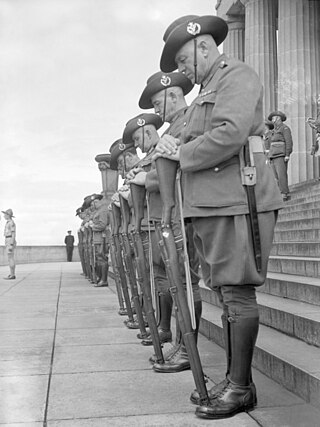
Reverse arms and the related rest on arms reversed are military drill commands used as a mark of respect at funerals and on occasions of mourning, especially in the armed forces of Commonwealth nations. When marching in reverse arms the soldier's weapon is held pointing behind them and grasped behind their back. When resting on reversed arms the weapon points towards the ground and the eyes are lowered.
{{cite web}}: CS1 maint: multiple names: authors list (link)